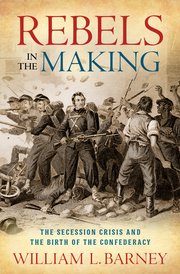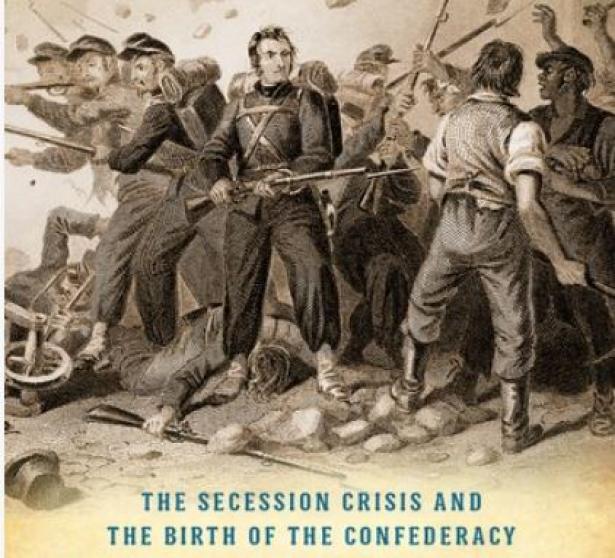books You’re Tearing Me Apart: On William L. Barney’s “Rebels in the Making: The Secession Crisis and the Birth of the Confederacy”
SECESSION OF CONFEDERATE STATES from the Union in 1861 was the inevitable crest of the defensive battles fought by slaveholders after the first moral assaults on slavery emerged in the late 18th century.
The Enlightenment and other liberation ideologies had put slavery under fire, an attack that intensified with the abolition of the overseas trade in kidnapped humans in 1808. Meanwhile, a new middle class was emerging with republican sensibilities, and the old order was starting to crumble in Europe.
“This was the international context of insurgent liberalism that the Confederacy sought to reverse with its bid for a reactionary slaveholders’ republic ruled by a landed elite,” writes William L. Barney in his masterly new study, Rebels in the Making.
Rebels in the Making: The Secession Crisis and the Birth of the Confederacy
By William L. Barney
Oxford University Press; 392 Pages
August 3, 2020
Hardcover: $34.95
ISBN-13: 9780190076085

...
The election of Abraham Lincoln in 1860 and the fear of antislavery agents spreading a freedom message in the South created intense paranoia that the Southern way of life and its institutions were under attack. And many Northern political figures, including President James Buchanan, remained sympathetic to the South’s position, and to their Southern colleagues in Congress. Abolitionists were a minority even in the North, and often reviled, but their voices were becoming more insistent.
Rebels in the Making, the first one-volume narrative history of secession in all the 15 slave states, is both a withering indictment of secessionist folly and a concerted attempt to examine the divergent and often contradictory threads of its fabric. The years 1860 and 1861 were pivotal, but Barney, a professor of history at the University of North Carolina at Chapel Hill, also demonstrates how revolt had been fomenting for decades.
Rebels documents the initial circumspection of the more prosperous members of the planter class and locates the impetus for secession in the rungs below them: younger slaveholders whose aspirations for higher status were thwarted, in part, by increasing economic decay.
An early Faustian bargain set the stage for later disaster. Delegates to the Constitutional Convention of 1787 negotiated key protections for slaves as property and the unassailable power of masters. The nullification crisis of 1832–’33 was only the first flare-up of the hardwired trouble the new nation had created for itself. The stakes rose with the emergence of organized abolitionism.
The drive for secession evolved incrementally (with many a setback) on a state-by-state basis, albeit with much of South Carolina’s planter class and notorious “fire-eaters” applying a bellows to the flame. While its Lowcountry planter class dreamed of regaining lost glory, the most fervent of the radical demagogues were not above intimidation, rigged elections, and violence to push their agenda. More conservative and Unionist political elements in the South impeded them for a time, but the latter’s hopes for accommodation or compromise vanished with Lincoln’s call for troops.
The war that came claimed a staggering 750,000 lives — the price some were willing to pay, and others compelled to pay, for the defense of slavery. But as Barney notes, slaughter and immediate postwar ruin was only a down payment on the South’s bill of atonement.
For all the persistent noise about “state’s rights” having been the real linchpin of secession, Barney produces a barrage of incontrovertible evidence that the war was entirely about slavery, as attested to again and again by prominent Southern whites of the day. “The prime cause of this conflict is African slavery in this country,” declared South Carolina planter Henry Ravenel. “On the issue of the contest rests its triumph or its complete overthrow.”
No ruling class relinquishes power willingly, and secessionists claiming Northern “usurpation” and “aggression” saw the only alternative to departing the Union as one of desecration of the white race, the degradation of Southern manhood, economic collapse, and anarchy.
“The liberty to own slaves, fears of those same slaves, defense of their homes, and a demand for the respect of an outside world that defamed them as sinners were all one and the same as a motive for secession and independence,” Barney writes.
For their part, many yeoman whites and recent European immigrants in the South feared competition from emancipated slaves for a dwindling number of jobs. Radicals, by contrast, embraced the idyll of an agrarian republic unimpeded by working-class discontent and any competition from manufacturing interests. It was a pipe dream.
Repression notwithstanding, a few dissenting voices could be heard in the South. Not the least of them was James L. Petigru, a South Carolina politician and jurist of Charleston who proclaimed that the Confederacy was “formed on principles that are hollow and rotten, on the shallow conceit that all nations will pay tribute to King Cotton, and that our new reading of ‘The Whole Duty of Man’ will be accepted by Christendom.”
Secessionists’ miscalculations and delusions of the grandeur to come when the South was an independent nation, thus securing the moral and legal continuance of slavery, were legion. To the modern observer, they seem ludicrous. Secessionists maintained the Confederacy’s constitution was the true democratic instrument, all the while asserting that the welfare of slaves under Southern stewardship was vastly more benign. They claimed secession’s supposed popular support in the Lower South, where slavery suffused every aspect of life, derived from the whole of Southern society. But they ignored the fact that this “groundswell” was top-down: heavily influenced by the secessionists’ iron grip on governorships, state legislatures, and, most egregiously, the pulpit and much of the press.
It could be argued, as Barney does forcefully, that in many cases secession had no direct mandate from the people whatsoever. In the months leading up to secession, all opposition was quashed, often violently.
“Secession and Southern independence meant little to the poorest one-third of whites who owned neither land nor slaves,” he writes. “They entered the Confederate army primarily through the forced mechanism of the draft.”
The move to secession was filled with complexities and conundrums of the first order, with geographic, economic, cultural, class, and even slaveholder divisions. Barney details them exhaustively. So exhaustively, in fact, that were it not for his cogent organization and interpretation of the historical record, lay readers would get lost in the thickets. Even so, the sheer number of political machinations, shifting alliances, and class conflicts can be dizzying, despite the book’s accessibility to the general reader.
He gives full credit to an army of scholars who preceded him in the field, cementing his fascination with the period, from his student days at Columbia University to the present. But today, at 77, and with numerous titles published on the Civil War era, he is widely esteemed for his particular acumen, the probing quality of his research, and his considerable skills as a storyteller. Rebels in the Making is a narrative shot through with missed opportunities, appalling capitulations, extraordinary arrogance, unexpected fortitude, and a measure of disbelief that so great an American tragedy as the Civil War should have come to pass.
Even today, some still glorify postwar Confederate memories of “selfless sacrifice on the altar of Southern liberties,” oft coupled with gauzy moonlight and magnolias myths for the tourists. Barney gives such romantic nonsense the dismissal it deserves. As he concludes, “The legacy of secession was the prostrate South at war’s end engulfed in an unfathomable tragedy of death, poverty, and broken bodies.”
[Bill Thompson, a freelance book critic, arts and travel writer, is the former book review editor, film critic, and arts editor of The Charleston (S.C.) Post and Courier.]


Spread the word